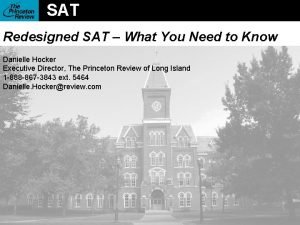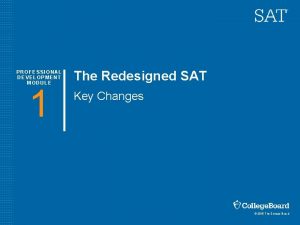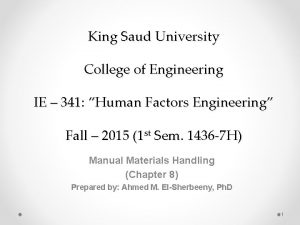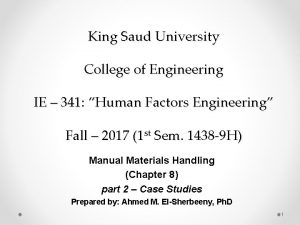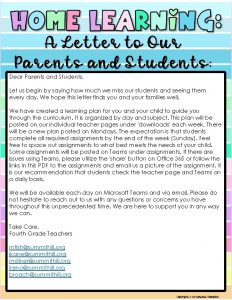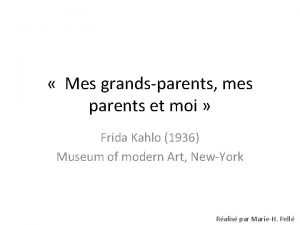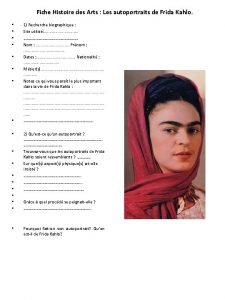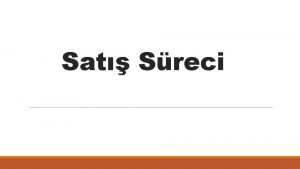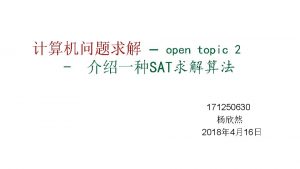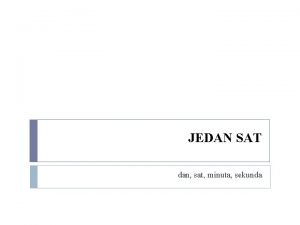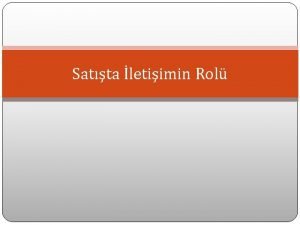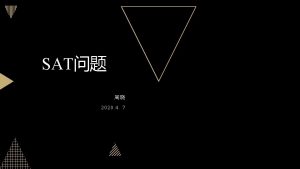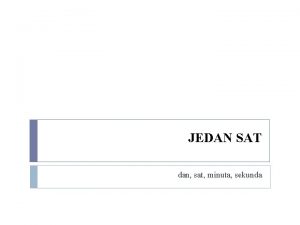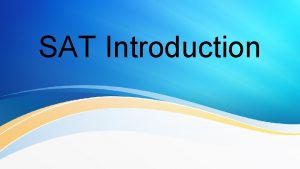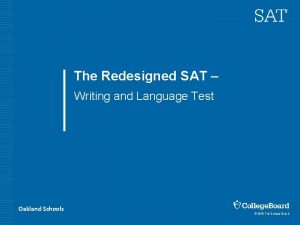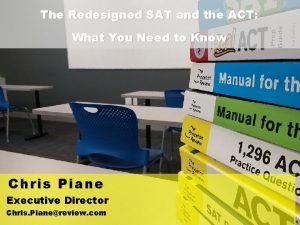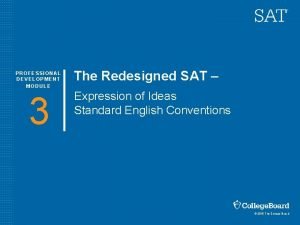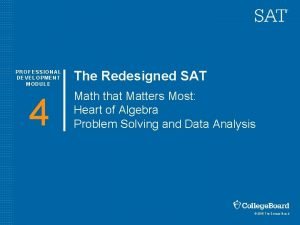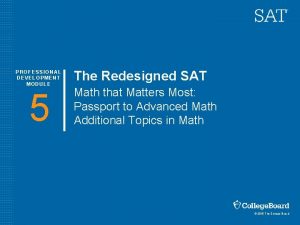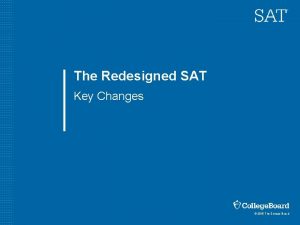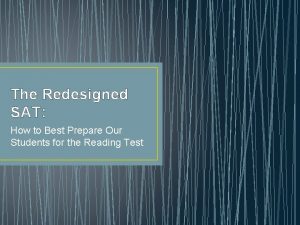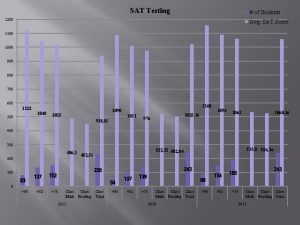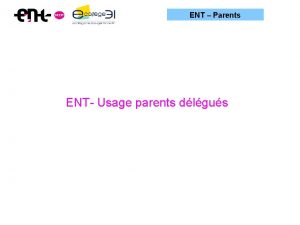The Redesigned SAT What Students and Parents Need











![Command of Evidence Sample Question [. . . ] Transportation planners perform critical work Command of Evidence Sample Question [. . . ] Transportation planners perform critical work](https://slidetodoc.com/presentation_image/29cec5d4185b1c22d2b0385f440d692f/image-12.jpg)








![Optional Essay Prompt As you read the passage below, consider how [the author] uses Optional Essay Prompt As you read the passage below, consider how [the author] uses](https://slidetodoc.com/presentation_image/29cec5d4185b1c22d2b0385f440d692f/image-21.jpg)












- Slides: 33

The Redesigned SAT What Students and Parents Need to Know 1

COMPARISON OF THE MAJOR FEATURES: OF THE CURRENT SAT AND REDESIGNED SATCategory Previous SAT Redesigned SAT Total Testing Time (Subject to research) 3 hours and 45 minutes 3 hours (plus 50 minutes for the Essay [optional]) Components § § § § Important Features » Emphasis on critical reading skills » » » Essay 2 Critical Reading (3 sections) Writing (2 sections) Mathematics (3 sections) Essay (not optional) One variable section Largely random order Shorter sections through complex passages Emphasis on vocabulary, particularly through sentence completions Five versus four answer choices Broad range of grammatical concepts tested via sentence improvement and sentence error identification Broad range of math concepts tested, including Geometry (28%). Many math problems were mathematical reasoning, unrelated to specific curriculum Scoring (a point for a correct answer and a deduction for an incorrect answer; blank responses had no impact on scores) Reading and Writing Section (Sections 1 and 2) Reading Test – 5 Passages Writing and Language Test – Includes charts and graphs. Math Section (Sections 3 and 4) No calculator, followed by calculator optional Essay optional Predictable order Longer sections » Continued emphasis on critical reading; questions will require a greater command » » » of evidence from the passage. Inclusion of at least one text from the U. S. Founding Documents and/or The Great Global Conversation Greater emphasis on the meaning of words in extended contexts and on how word choice shapes meaning, tone, and impact Four answer choices Greater emphasis on editing skills than grammatical concepts; students will edit and revise texts from various sources. Almost exactly like the ACT Writing section, with charts Three essential areas of focus, much less emphasis on Geometry. For most students, the math will seem more difficult due to multiple concepts being tested within the same question, and the presence of distracters Rights-only scoring (a point for a correct answer but no deduction for an incorrect answer; blank responses have no impact on scores) » Required and given at the beginning of » Optional and given at the end of the SAT; postsecondary institutions determine the SAT » 25 minutes to write the essay » Tests writing skill; students take a position on a presented issue » 50 minutes to write the essay » Tests reading, analysis, and writing skills; students produce a written analysis of a whether they will require the essay for admission provided source text © 2015 The College Board

Test-Length Comparison COMPARISON OF TEST LENGTH AND TIMING: CURRENT SAT AND REDESIGNED SAT Current SAT Redesigned SAT Time Allotted (minutes) Number of Questions/ Tasks Critical Reading 70 67 Reading 65 52 Writing 60 49 Writing and Language 35 44 Essay 25 1 Essay (optional) 50 1 Mathematics 70 54 Math 80 58 Total 225 171 Total 180 (230 with Essay) 154 (155 with Essay) Component 3 Component © 2015 The College Board

Score Reporting on the Redesigned SAT 4 © 2015 The College Board

How Is It Calculated? ► Raw scores (the number of correct answers) are converted to scaled scores. ► The scaled scores for Reading and Writing are added and then multiplied by 10 to arrive at a single three digit score for Evidence-Based Reading and Writing. ► The scaled scores for Math are converted to a three digit scaled score. ► The Reading and Writing score (single) is added to the Math score to get the total/composite score on a scale of 400 -1600. ► Essay score is totally separate, three scores from two different readers on a scale of 1 -4, meaning eight points possible per section. Total: 24. ► Subscores are reported on scales of 1 -15 and provide information about strengths and weaknesses. ► This is all a work in progress! 5 © 2015 The College Board

What’s A Good SAT Score? ► Who knows? Currently, there is no data, since there is not a single student who has taken the redesigned SAT. ► Students who test in March will not receive scores until May (likely after the May test) to give College Board the time necessary to fine tune scales, curves and concordance tables. ► The PSAT used to be a predictor of SAT performance; however, the PSAT charts and percentiles released are a) preliminary, b) not on the exact same scale as the SAT and c) potentially inflated. ► The higher, the better. The next slide is an excerpt from an estimated table to ACT to New SAT to Previous SAT conversions, drawn from best available information. It all depends on the school you want to attend. 6 © 2015 The College Board

Conversion Table ACT New SAT Old SAT 35 1540 -1590 2290 -2370 33 1440 -1480 2140 -2210 31 1360 -1390 2020 -2070 29 1290 -1320 1920 -1970 27 1210 -1240 1800 -1850 25 1130 -1160 1680 -1730 23 1050 -1080 1560 -1610 21 980 -1010 1450 -1500 7 © 2015 The College Board

SAT Says: Key Changes in the Redesigned SAT 1. Words in Context – Fallacy that advanced vocabulary has been eliminated. 2. Command of Evidence – Will be a strong component of success in Reading, Writing and Essay sections. Prove it! 3. Essay Analyzing a Source – Rhetorical analysis of an author’s argument; students own opinion is irrelevant. 4. Math That Matters Most – Three essential areas are Problem Solving and Data Analysis (ratios, percentages and proportional reading; Heart of Algebra (linear equations and systems, with an emphasis on abstraction); and Passport to Advanced Math (manipulation of complex equations). Some geometry and trigonometry tested. 5. Problems Grounded in Real-World Contexts. Inclusion of charts, graphs and tables in Reading and Writing sections. Real-world scenarios in math. 6. Analysis in Science and Analysis in History/Social Studies. Infuses all sections. 7. U. S. Founding Documents and the Great Global Conversation. 8. No Penalty for Guessing 8 © 2015 The College Board

Evidence-Based Reading and Writing Overview ► Evidence-Based Reading and Writing Section comprises the Reading Test and the Writing and Language Test (sections 1 and 2) ► Text complexity: 9 th grade through first year post-high school ► Emphasis on source analysis and use of evidence ► Inclusion of data and informational graphics ► Focus on words in context and on word choice for rhetorical effect ► Students work with texts in literature, science and social studies 9 © 2015 The College Board

Words In Context Sample Question – Passage (abbreviated) 1 Today, I am an inquisitor. An hyperbole would not be fictional and would not overstate the solemnness that I feel right now. My faith in the Constitution is whole; it is complete; it is total. And I am not going to sit here and be 5 an idle spectator to the diminution, the subversion, the destruction, of the Constitution. “Who can so properly be the inquisitors for the nation as the representatives of the nation themselves? ” “The subjects of its jurisdiction are those offenses which 10 proceed from the misconduct of public men. ” 10 © 2015 The College Board

Reading Test Sample Question The main rhetorical effect of the series of three phrases in lines 5– 6 (“the diminution, the subversion, the destruction”) is to A) convey with increasing intensity the seriousness of the threat Jordan sees to the Constitution. B) clarify that Jordan believes the Constitution was first weakened, then sabotaged, then broken. C) indicate that Jordan thinks the Constitution is prone to failure in three distinct ways. D) propose a three-part agenda for rescuing the Constitution from the current crisis. Content: Rhetoric / Analyzing word choice Objective: Students must determine the main rhetorical effect of the speaker’s choice of words. 11 © 2015 The College Board
![Command of Evidence Sample Question Transportation planners perform critical work Command of Evidence Sample Question [. . . ] Transportation planners perform critical work](https://slidetodoc.com/presentation_image/29cec5d4185b1c22d2b0385f440d692f/image-12.jpg)
Command of Evidence Sample Question [. . . ] Transportation planners perform critical work within the broader field of urban and regional planning. As of 2010, there were approximately 40, 300 urban and regional planners employed in the United States. The United States Bureau of Labor Statistics forecasts steady job growth in this field, projecting that 16 percent of new jobs in all occupations will be related to urban and regional planning. Population growth and concerns about environmental sustainability are expected to spur the need for transportation planning professionals. 12 © 2015 The College Board

Command of Evidence Sample Question (continued) Which choice completes the sentence with accurate data based on the above graph? A) NO CHANGE B) warning, however, that job growth in urban and regional planning will slow to 14 percent by 2020. C) predicting that employment of urban and regional planners will increase 16 percent between 2010 and 2020. D) indicating that 14 to 18 percent of urban and regional planning positions will remain unfilled. CONTENT: Synthesis: Analyzing Quantitative Information 13 © 2015 The College Board

Writing and Language Test Overview ► Assesses college and career readiness proficiency in revising and editing a range of texts. ► Does not require students to provide written responses -- multiple-choice questions only. ► Attends to a core set of standard English language conventions and to effective written expression. ► Some passages and/or questions will be accompanied by representations of data — tables, charts, graphs, etc. ► The most common question format will require students to choose the best of three alternatives to an indicated part of the passage (often an underlined portion) or to determine that the version presented in the passage is the best option. 14 © 2015 The College Board

Standard English Conventions ► Students will read a passage, and then answer questions about what corrections are needed (if any) pertaining to: 15 - Sentence structure: questions focus on editing text to correct problems in sentence formation and inappropriate shifts in construction within and between sentences. - Conventions of Usage: questions focus on editing text to ensure conformity to the conventions of standard written English usage. - Conventions of Punctuation: questions focus on editing text to ensure conformity to the conventions of standard written English punctuation. © 2015 The College Board

Sample Question A 1954 documentary about renowned watercolor painter Dong Kingman shows the artist sitting on a stool on Mott Street in New York City’s Chinatown. A crowd of admiring spectators watches as Kingman squeezes dollops of paint from several tubes into a tin watercolor [2] box, from just a few primary colors, Kingman creates dozens of beautiful hues as he layers the translucent paint onto the paper on his easel. Each stroke of the brush and dab of the sponge transforms thinly sketched outlines into buildings, shop signs, and streetlamps. A) NO CHANGE B) box. From just a few primary colors, C) box from just a few primary colors, D) box, from just a few primary colors Content: Standard English Conventions/Conventions of Punctuation Objective: Students must create two grammatically complete and standard sentences. 16 © 2015 The College Board

Expression of Ideas ► Students will revise and edit extended texts across a range of academic and career-related subjects show facility with a core set of grammar, usage, and punctuation conventions ► Questions focus on revision of text: topic development accuracy (consistency between text and graphic[s]) logic cohesion rhetorically effective use of language. ► Some passages are based in science and history/social studies 17 These passages contribute to Analysis in Science and Analysis in History/Social Studies cross-test scores © 2015 The College Board

Sample Question Please read Dong Kingman: Painter of Cities to answer the following question: His broader brush strokes and sponge-painted shapes create majestic city skylines, with skyscrapers towering in the background, bridges connecting neighborhoods on either side of a river, and [ 3 ] delicately painted creatures, such as a tiny, barely visible cat prowling in the bushes of a park. 3. The writer wants to complete the sentence with a third example of a detail Kingman uses to create his majestic city skylines. Which choice best accomplishes this goal? A) NO CHANGE B) exquisitely lettered street and storefront signs. C) other city details that help define Kingman’s urban landscapes. D) enormous ships maneuvering out of a busy harbor. CONTENT: Expression of Ideas: Development/Support 18 © 2015 The College Board

Sample Question In 1936, a critic described one of Kingman’s solo exhibits as “twenty of the freshest, most satisfying watercolors that have been seen hereabouts in many a day. ” [ 4 ] 4. The writer wants to conclude the passage with a sentence that emphasizes an enduring legacy of Kingman’s work. Which choice would best accomplish this goal? A) Although Kingman’s work might not be as famous as that of some other watercolor painters, such as Georgia O’Keeffe and Edward Hopper, it is well regarded by many people. B) Since Kingman’s death in 2000, museums across the United States and in China have continued to ensure that his now-iconic landscapes remain available for the public to enjoy. C) The urban landscapes depicted in Kingman’s body of work are a testament to aptness of the name chosen for Kingman when he was just a boy. D) Kingman’s work was but one example of a long-lasting tradition refreshed by an innovative artist with a new perspective CONTENT: Expression of Ideas: Organization/Introductions, Conclusions, and Transitions 19 © 2015 The College Board

Optional Essay Overview ► Students who opt to take the SAT Essay are required to make purposeful, substantive use of textual evidence in a way that can be objectively evaluated. ► The essay task is not designed to elicit students’ subjective opinions. ► The prompt will remain consistent for all administrations of the SAT; only the writing passages will change. ► Students will receive three scores of 2 -8 in Reading, Writing, and Analysis. 20 © 2015 The College Board
![Optional Essay Prompt As you read the passage below consider how the author uses Optional Essay Prompt As you read the passage below, consider how [the author] uses](https://slidetodoc.com/presentation_image/29cec5d4185b1c22d2b0385f440d692f/image-21.jpg)
Optional Essay Prompt As you read the passage below, consider how [the author] uses evidence, such as facts or examples, to support claims. ► reasoning to develop ideas and to connect claims and evidence. ► stylistic or persuasive elements, such as word choice or appeals to emotion, to add power to the ideas expressed. ► Source Text Write an essay in which you explain how [the author] builds an argument to persuade [his/her] audience that [author’s claim]. In your essay, analyze how [the author] uses one or more of the features listed above (or features of your own choice) to strengthen the logic and persuasiveness of [his/her] argument. Be sure that your analysis focuses on the most relevant aspects of the passage. Your essay should not explain whether you agree with [the author’s] claims, but rather explain how [he/she] builds an argument to persuade [his/her] audience. 21 © 2015 The College Board

Math Test Overview ► Focus on content that matters most for college and career readiness: - ► • Algebra and linear equations • Problem solving and data analysis • Advanced mathematical practices Certain key elements will be woven throughout the Math Test: - 22 Assesses fluency with, understanding of, and ability to apply mathematical concepts Emphasis on mathematical application and reasoning Problems from a range of disciplines addressing real-world problems drawn from science, social studies, and careers Inclusion of both calculator and no-calculator portions as well as attention to the use of a calculator as a tool Includes both multiple choice questions and student-produced response questions © 2015 The College Board

Passport To Advanced Math Sample Question (No calculator portion) What is one possible solution to the equation This example, from the no-calculator portion of the test, requires students to look at the structure of the expression and find a way to rewrite it, again showing the link between fluency and mathematical practices. The student must transform the expression without a calculator, for example by multiplying both sides of the equation by a common denominator as a first step to find the solution. *This is an example of a “Student-Produced Response” or grid-in question. Students will not be given answer choices. Instead, they fill in the grid with their answers. Approximately 20% of the math test contains student-produced response questions. Content: Passport to Advanced Math 23 © 2015 The College Board

Passport To Advanced Math Sample Question (No calculator portion) In this problem, multiplying both sides of the equation by the common denominator (x + 1)(x − 1) yields 24(x − 1) − 12(x + 1) = (x + 1)(x − 1). Multiplication and simplification then yields 12 x − 36 = x 2 − 1, or x 2 − 12 x + 35 = 0. Factoring the quadratic gives (x − 5)(x − 7) = 0, so the solutions occur at x = 5 and x = 7, both of which should be checked in the original equation to ensure that they are not extraneous. In this case, both values are solutions. 24 © 2015 The College Board

Heart of Algebra (Calculator) When a scientist dives in salt water to a depth of 9 feet below the surface, the pressure due to the atmosphere and surrounding water is 18. 7 pounds per square inch. As the scientist descends, the pressure increases linearly. At a depth of 14 feet, the pressure is 20. 9 pounds per square inch. If the pressure increases at a constant rate as the scientist’s depth below the surface increases, which of the following linear models best describes the pressure p in pounds per square inch at a depth of d feet below the surface? A) p = 0. 44 d + 0. 77 B) p = 0. 44 d + 14. 74 C) p = 2. 2 d – 1. 1 D) p = 2. 2 d – 9. 9 25 © 2015 The College Board

Heart of Algebra: Answer Explanation Choice B is correct. To determine the linear model, one can first determine the rate at which the pressure due to the atmosphere and surrounding water is increasing as the depth of the diver increases. Calculating this gives Then one needs to determine the pressure due to the atmosphere or, in other words, the pressure when the diver is at a depth of 0. Solving the equation 18. 7 = 0. 44 ( 9 ) + b gives b = 14. 74. Therefore, the model that can be used to relate the pressure and the depth is p = 0. 44 d + 14. 74. 26 © 2015 The College Board

Problem Solving and Data Analysis: Sample Question (Calculator) A typical image taken of the surface of Mars by a camera is 11. 2 gigabits in size. A tracking station on Earth can receive data from the spacecraft at a data rate of 3 megabits per second for a maximum of 11 hours each day. If 1 gigabit equals 1, 024 megabits, what is the maximum number of typical images that the tracking station could receive from the camera each day? A) 3 B) 10 C) 56 D) 144 27 © 2015 The College Board

Problem Solving and Data Analysis: Answer Explanation Choice B is correct. The tracking station can receive 118, 800 megabits each day which is about 116 gigabits each day If each image is 11. 2 gigabits, then the number of images that can be received each day is Since the question asks for the maximum number of typical images, rounding the answer down to 10 is appropriate because the tracking station will not receive a complete 11 th image in one day. 28 © 2015 The College Board

How To Prepare for the Redesigned SAT § Khan Academy. One of the biggest challenges is the paucity of reliable practice materials. College Board has released exactly four practice tests. The content publishers who already have books on the market wrote them before CB even released content and are, at best, total conjecture. § Use the four practice tests judiciously – we used one for the mock. Save the others to complete on a full-length, timed basis and use the practice questions that College Board previously released (on College Board site) in addition to Khan Academy. § College Board also has a daily practice app for Apple and Android phones. § Build your reading stamina and practice paraphrasing. The new SAT requires students to come into the test with a higher reading level than either the old SAT or the ACT. Students will need to deal with obscure vocabulary, complex (or archaic) sentence structure and advanced topics, including science passages that contain jargon. Read and practice condensing long and complex sentences into sound bites – old SAT reading sections, higher level magazine articles, and top-tier newspaper articles can help. 29 © 2015 The College Board

How To Prepare for the Redesigned SAT § Where’s the evidence? Get into the habit of backing up any answer with relevant quotations or data that support your answer. This will help you not only in SAT preparation, but in preparation for almost any test. Don’t choose an answer unless you point to the evidence it is correct. § Get excited about the U. S. Founding Documents. Understanding them in advance will be helpful on test day. § Make sure you are going to get the “freebies” on test day by knowing the standards and conventions of English language – comma placement, semi-colon use, pronoun-antecedent agreement, etc. Any released ACT English section will be good practice for the SAT Writing section. § Put away the calculator (some of the time). Both the ACT and the old SAT math sections were designed to be solved without the need of a calculator; however, students are calculator-dependent. The new SAT forces students to out down their calculator and use their heads, for at least part of the test. Start practicing SAT Math (all math!) without immediately resorting to the calculator in order to break the habit. 30 © 2015 The College Board

Practice with Khan Academy ® ► The College Board and Khan Academy have partnered to provide online SAT test preparation programs and resources entirely free of charge. ► Khan Academy has released an interactive and personalized practice program for the redesigned SAT. ► Features include: - Thousands of practice problems - Personalized tutorials on test content - Official SAT practice questions and full-length tests - Comprehensive reporting for students - Access anytime, anywhere — for free ► The College Board is working with educators, community groups, college access organizations, and parents to provide the necessary resources to propel students to college success. 31 © 2015 The College Board

So why not just take the ACT and forget the redesigned SAT? Plus Minus Virtually all colleges will accept the ACT and SAT equally. Speed. The ACT is a killer for more slower readers/more deliberate processors. Easier reading passages. Science section is a score drag for many students. Single-concept math questions, no distracters. Straightforward grammar and editing. Many, many more reliable and vetted resources for study. 32 No delays in scores or changes in scale. Colleges know how to handle. © 2015 The College Board

Practice! The only way to know if you can handle the pacing demands of the ACT is to take a full-length practice test! ► Full-length, proctored practice ACT will be offered at Del Norte on Saturday, March 5, from 9: 00 a. m. – 1: 00 p. m. ► Sponsored by the Del Norte PTSA. 33 © 2015 The College Board
 Sat time length
Sat time length Redesigned sat 1
Redesigned sat 1 Satkey
Satkey Rwl redesigned
Rwl redesigned Rwl redesigned
Rwl redesigned Dear students and parents
Dear students and parents Grand parent de frida kahlo
Grand parent de frida kahlo Parents parents
Parents parents Fiche frida kahlo
Fiche frida kahlo Salute to luna and hidalgo
Salute to luna and hidalgo Hình ảnh bộ gõ cơ thể búng tay
Hình ảnh bộ gõ cơ thể búng tay Frameset trong html5
Frameset trong html5 Bổ thể
Bổ thể Tỉ lệ cơ thể trẻ em
Tỉ lệ cơ thể trẻ em Chó sói
Chó sói Glasgow thang điểm
Glasgow thang điểm Chúa yêu trần thế alleluia
Chúa yêu trần thế alleluia Các môn thể thao bắt đầu bằng tiếng đua
Các môn thể thao bắt đầu bằng tiếng đua Thế nào là hệ số cao nhất
Thế nào là hệ số cao nhất Các châu lục và đại dương trên thế giới
Các châu lục và đại dương trên thế giới Công thức tiính động năng
Công thức tiính động năng Trời xanh đây là của chúng ta thể thơ
Trời xanh đây là của chúng ta thể thơ Mật thư tọa độ 5x5
Mật thư tọa độ 5x5 Làm thế nào để 102-1=99
Làm thế nào để 102-1=99 Phản ứng thế ankan
Phản ứng thế ankan Các châu lục và đại dương trên thế giới
Các châu lục và đại dương trên thế giới Thơ thất ngôn tứ tuyệt đường luật
Thơ thất ngôn tứ tuyệt đường luật Quá trình desamine hóa có thể tạo ra
Quá trình desamine hóa có thể tạo ra Một số thể thơ truyền thống
Một số thể thơ truyền thống Bàn tay mà dây bẩn
Bàn tay mà dây bẩn Vẽ hình chiếu vuông góc của vật thể sau
Vẽ hình chiếu vuông góc của vật thể sau Nguyên nhân của sự mỏi cơ sinh 8
Nguyên nhân của sự mỏi cơ sinh 8 đặc điểm cơ thể của người tối cổ
đặc điểm cơ thể của người tối cổ Thế nào là giọng cùng tên?
Thế nào là giọng cùng tên?

